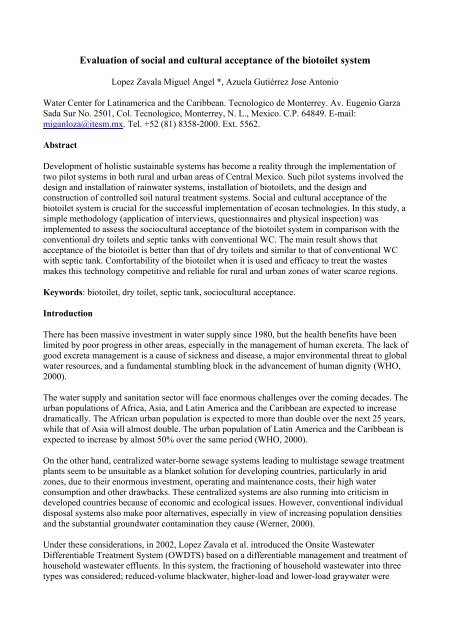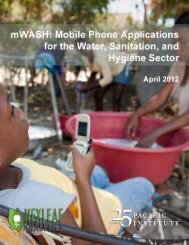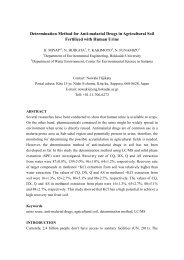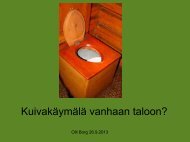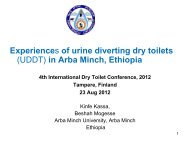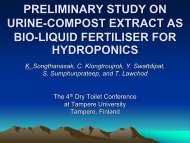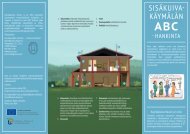Evaluation of social and cultural acceptance of the biotoilet system
Evaluation of social and cultural acceptance of the biotoilet system
Evaluation of social and cultural acceptance of the biotoilet system
You also want an ePaper? Increase the reach of your titles
YUMPU automatically turns print PDFs into web optimized ePapers that Google loves.
<strong>Evaluation</strong> <strong>of</strong> <strong>social</strong> <strong>and</strong> <strong>cultural</strong> <strong>acceptance</strong> <strong>of</strong> <strong>the</strong> <strong>biotoilet</strong> <strong>system</strong><br />
Lopez Zavala Miguel Angel *, Azuela Gutiérrez Jose Antonio<br />
Water Center for Latinamerica <strong>and</strong> <strong>the</strong> Caribbean. Tecnologico de Monterrey. Av. Eugenio Garza<br />
Sada Sur No. 2501, Col. Tecnologico, Monterrey, N. L., Mexico. C.P. 64849. E-mail:<br />
miganloza@itesm.mx. Tel. +52 (81) 8358-2000. Ext. 5562.<br />
Abstract<br />
Development <strong>of</strong> holistic sustainable <strong>system</strong>s has become a reality through <strong>the</strong> implementation <strong>of</strong><br />
two pilot <strong>system</strong>s in both rural <strong>and</strong> urban areas <strong>of</strong> Central Mexico. Such pilot <strong>system</strong>s involved <strong>the</strong><br />
design <strong>and</strong> installation <strong>of</strong> rainwater <strong>system</strong>s, installation <strong>of</strong> <strong>biotoilet</strong>s, <strong>and</strong> <strong>the</strong> design <strong>and</strong><br />
construction <strong>of</strong> controlled soil natural treatment <strong>system</strong>s. Social <strong>and</strong> <strong>cultural</strong> <strong>acceptance</strong> <strong>of</strong> <strong>the</strong><br />
<strong>biotoilet</strong> <strong>system</strong> is crucial for <strong>the</strong> successful implementation <strong>of</strong> ecosan technologies. In this study, a<br />
simple methodology (application <strong>of</strong> interviews, questionnaires <strong>and</strong> physical inspection) was<br />
implemented to assess <strong>the</strong> socio<strong>cultural</strong> <strong>acceptance</strong> <strong>of</strong> <strong>the</strong> <strong>biotoilet</strong> <strong>system</strong> in comparison with <strong>the</strong><br />
conventional dry toilets <strong>and</strong> septic tanks with conventional WC. The main result shows that<br />
<strong>acceptance</strong> <strong>of</strong> <strong>the</strong> <strong>biotoilet</strong> is better than that <strong>of</strong> dry toilets <strong>and</strong> similar to that <strong>of</strong> conventional WC<br />
with septic tank. Comfortability <strong>of</strong> <strong>the</strong> <strong>biotoilet</strong> when it is used <strong>and</strong> efficacy to treat <strong>the</strong> wastes<br />
makes this technology competitive <strong>and</strong> reliable for rural <strong>and</strong> urban zones <strong>of</strong> water scarce regions.<br />
Keywords: <strong>biotoilet</strong>, dry toilet, septic tank, socio<strong>cultural</strong> <strong>acceptance</strong>.<br />
Introduction<br />
There has been massive investment in water supply since 1980, but <strong>the</strong> health benefits have been<br />
limited by poor progress in o<strong>the</strong>r areas, especially in <strong>the</strong> management <strong>of</strong> human excreta. The lack <strong>of</strong><br />
good excreta management is a cause <strong>of</strong> sickness <strong>and</strong> disease, a major environmental threat to global<br />
water resources, <strong>and</strong> a fundamental stumbling block in <strong>the</strong> advancement <strong>of</strong> human dignity (WHO,<br />
2000).<br />
The water supply <strong>and</strong> sanitation sector will face enormous challenges over <strong>the</strong> coming decades. The<br />
urban populations <strong>of</strong> Africa, Asia, <strong>and</strong> Latin America <strong>and</strong> <strong>the</strong> Caribbean are expected to increase<br />
dramatically. The African urban population is expected to more than double over <strong>the</strong> next 25 years,<br />
while that <strong>of</strong> Asia will almost double. The urban population <strong>of</strong> Latin America <strong>and</strong> <strong>the</strong> Caribbean is<br />
expected to increase by almost 50% over <strong>the</strong> same period (WHO, 2000).<br />
On <strong>the</strong> o<strong>the</strong>r h<strong>and</strong>, centralized water-borne sewage <strong>system</strong>s leading to multistage sewage treatment<br />
plants seem to be unsuitable as a blanket solution for developing countries, particularly in arid<br />
zones, due to <strong>the</strong>ir enormous investment, operating <strong>and</strong> maintenance costs, <strong>the</strong>ir high water<br />
consumption <strong>and</strong> o<strong>the</strong>r drawbacks. These centralized <strong>system</strong>s are also running into criticism in<br />
developed countries because <strong>of</strong> economic <strong>and</strong> ecological issues. However, conventional individual<br />
disposal <strong>system</strong>s also make poor alternatives, especially in view <strong>of</strong> increasing population densities<br />
<strong>and</strong> <strong>the</strong> substantial groundwater contamination <strong>the</strong>y cause (Werner, 2000).<br />
Under <strong>the</strong>se considerations, in 2002, Lopez Zavala et al. introduced <strong>the</strong> Onsite Wastewater<br />
Differentiable Treatment System (OWDTS) based on a differentiable management <strong>and</strong> treatment <strong>of</strong><br />
household wastewater effluents. In this <strong>system</strong>, <strong>the</strong> fractioning <strong>of</strong> household wastewater into three<br />
types was considered; reduced-volume blackwater, higher-load <strong>and</strong> lower-load graywater were
concepts introduced in that model. The treatment <strong>of</strong> blackwater conceived a change in <strong>the</strong><br />
traditional way <strong>of</strong> using <strong>the</strong> toilet; <strong>the</strong> use <strong>of</strong> water in <strong>the</strong> toilet was thought just to clean <strong>the</strong> toilet,<br />
not to transport <strong>the</strong> toilet wastes; this was a very important change that it was possible by using <strong>the</strong><br />
<strong>biotoilet</strong>. Several benefits are derived from <strong>the</strong> implementation <strong>of</strong> <strong>the</strong> OWDTS, which can be found<br />
in Lopez Zavala et al. (2002).<br />
After <strong>the</strong> introduction <strong>of</strong> <strong>the</strong> OWDTS concept, intensive research was conducted to support<br />
scientifically <strong>the</strong> <strong>system</strong>. This goal was achieved successfully during <strong>the</strong> subsequent years, but <strong>the</strong><br />
implementation in practice <strong>of</strong> <strong>the</strong> <strong>system</strong> was an aim moving forward.<br />
Development <strong>of</strong> holistic sustainable <strong>system</strong>s based on <strong>the</strong> OWDTS concept has been achieved on<br />
<strong>the</strong> practice through <strong>the</strong> implementation <strong>of</strong> two pilot <strong>system</strong>s in both rural <strong>and</strong> urban areas <strong>of</strong><br />
Central Mexico, State <strong>of</strong> Guanajuato (Fig. 1). Such pilot <strong>system</strong>s involved <strong>the</strong> design <strong>and</strong><br />
installation <strong>of</strong> rainwater <strong>system</strong>s, installation <strong>of</strong> <strong>biotoilet</strong>s, <strong>and</strong> <strong>the</strong> design <strong>and</strong> construction <strong>of</strong><br />
controlled soil natural treatment <strong>system</strong>s (Fig. 2). Social <strong>and</strong> <strong>cultural</strong> <strong>acceptance</strong> <strong>of</strong> <strong>the</strong> <strong>biotoilet</strong><br />
<strong>system</strong> was a crucial <strong>and</strong> sensitive factor for <strong>the</strong> successful implementation <strong>of</strong> <strong>the</strong> OWDTS.<br />
Unfortunately, on literature <strong>the</strong>re was not available a <strong>system</strong>atic methodology to assess <strong>the</strong> <strong>social</strong><br />
<strong>and</strong> <strong>cultural</strong> <strong>acceptance</strong> <strong>of</strong> <strong>the</strong> <strong>biotoilet</strong> o similar <strong>system</strong>. The German International Cooperation<br />
Agency (GTZ) has presented reports in different congresses where <strong>the</strong> socio<strong>cultural</strong> <strong>acceptance</strong> <strong>of</strong><br />
ecosan technologies has been evaluated; however, details <strong>of</strong> <strong>the</strong> methodology implemented are not<br />
deeply described (Werner et al., 2003). In Mexico, <strong>the</strong>re are not reports where similar evaluation<br />
has been conducted during introduction <strong>of</strong> new technologies. Thus, in this study, a simple<br />
methodology was implemented to assess <strong>the</strong> socio<strong>cultural</strong> <strong>acceptance</strong> <strong>of</strong> <strong>the</strong> <strong>biotoilet</strong> <strong>system</strong>.<br />
Methods<br />
The first questions that arose during this study were “what kind <strong>of</strong> technology will be compared<br />
with <strong>the</strong> <strong>biotoilet</strong> <strong>and</strong> how <strong>the</strong> <strong>acceptance</strong> will be assessed”. Trying to answer <strong>the</strong>se questions <strong>the</strong><br />
procedure adopted was as follows:<br />
1. Selection <strong>of</strong> sanitation technologies against <strong>the</strong> <strong>biotoilet</strong> <strong>acceptance</strong> was compared.<br />
Based on <strong>of</strong>ficial governmental reports at municipal, state <strong>and</strong> federal level, <strong>the</strong> most<br />
common technologies promoted <strong>and</strong> used for onsite sanitation in <strong>the</strong> state <strong>of</strong> Guanajuato,<br />
Mexico were identified. These technologies were selected to assess <strong>the</strong>ir <strong>acceptance</strong> in<br />
comparison with that <strong>of</strong> <strong>the</strong> <strong>biotoilet</strong>.<br />
2. Preparation <strong>of</strong> a reliable survey format to assess <strong>the</strong> socio<strong>cultural</strong> <strong>acceptance</strong> <strong>of</strong> <strong>the</strong><br />
<strong>biotoilet</strong>. This step consisted in:<br />
a. Preparation <strong>of</strong> <strong>the</strong> survey format, contents <strong>and</strong> interviews to users.
. Pilot survey to assess <strong>the</strong> reliability <strong>of</strong> <strong>the</strong> contents, interviews <strong>and</strong> answers <strong>of</strong> users based<br />
on our expectations.<br />
c. Enrichment <strong>of</strong> contents, survey format <strong>and</strong> procedure to focus properly <strong>the</strong> interviews to <strong>the</strong><br />
users.<br />
3. Selection <strong>of</strong> <strong>the</strong> communities where <strong>the</strong> survey was conducted.<br />
With <strong>the</strong> help <strong>of</strong> <strong>of</strong>ficers from <strong>the</strong> Social Development Department (SDD) <strong>of</strong> Dolores<br />
Hidalgo Municipality, communities using onsite sanitation <strong>system</strong>s were first identified.<br />
Then, in agreement with <strong>of</strong>ficers, <strong>the</strong> communities subjected to be surveyed were selected<br />
r<strong>and</strong>omly from those already identified. Thus, users from <strong>the</strong>se communities <strong>and</strong> <strong>biotoilet</strong><br />
users were visited <strong>and</strong> interviewed in <strong>the</strong>ir homes.<br />
4. Interviews <strong>and</strong> physical inspection <strong>of</strong> sanitation <strong>system</strong>s.<br />
Members <strong>of</strong> different households with onsite sanitation <strong>system</strong>s were invited to attend <strong>the</strong><br />
interviews. Then, <strong>the</strong> interviews were conducted by master students <strong>and</strong> pr<strong>of</strong>essional staff <strong>of</strong><br />
<strong>the</strong> SDD <strong>of</strong> <strong>the</strong> Municipality. Household members <strong>of</strong> different ages <strong>and</strong> gender were<br />
selected.<br />
After interviews, users <strong>of</strong> <strong>the</strong> different sanitation technologies were asked to show <strong>the</strong>ir<br />
<strong>system</strong>s to conduct <strong>the</strong> physical inspection <strong>and</strong> take photographs as a pro<strong>of</strong> <strong>of</strong> <strong>the</strong> conditions<br />
under which <strong>the</strong> <strong>system</strong>s were operating. This step was remarkably important to ensure that<br />
<strong>the</strong> information provided during <strong>the</strong> interviews corresponded to that <strong>of</strong> physical inspections<br />
<strong>and</strong> consequently to obtain reliable data.<br />
5. Syn<strong>the</strong>sis <strong>and</strong> analysis <strong>of</strong> data collected during <strong>the</strong> survey.<br />
All survey formats used during <strong>the</strong> interviews <strong>and</strong> <strong>the</strong> photographs <strong>and</strong> comments generated<br />
by <strong>the</strong> interviewers were concentrated. Answers <strong>of</strong> users were analyzed statistically <strong>and</strong><br />
results were contrasted with <strong>the</strong> physical inspection results.<br />
2. Results <strong>and</strong> discussion<br />
1. Selection <strong>of</strong> sanitation technologies against <strong>the</strong> <strong>biotoilet</strong> <strong>acceptance</strong> was compared.<br />
In <strong>the</strong> last decades, <strong>the</strong> Government <strong>of</strong> <strong>the</strong> State <strong>of</strong> Guanajuato has promoted among rural<br />
<strong>and</strong> suburban communities <strong>the</strong> massive utilization <strong>of</strong> septic tanks with conventional WC as a
sanitation alternative. More recently, its promotion has moved towards <strong>the</strong> installation <strong>of</strong> dry<br />
toilets. Two types <strong>of</strong> dry toilets are mainly found, prefabricated made <strong>of</strong> glass fiber <strong>and</strong><br />
constructed on site made <strong>of</strong> masonry (Fig. 3). These technologies are onsite sanitation<br />
solutions; <strong>the</strong>refore, <strong>the</strong> <strong>biotoilet</strong> <strong>acceptance</strong> was compared with that <strong>of</strong> such alternatives.<br />
2. Preparation <strong>of</strong> a reliable survey format to assess <strong>the</strong> socio<strong>cultural</strong> <strong>acceptance</strong> <strong>of</strong> <strong>the</strong><br />
<strong>biotoilet</strong>.<br />
Complete survey format is not included in this paper because <strong>of</strong> its extension. However,<br />
Table 1 summarizes <strong>the</strong> survey format contents. As seen, <strong>the</strong> survey was divided into 9<br />
sections <strong>and</strong> <strong>the</strong> number <strong>of</strong> questions per each section is indicated in <strong>the</strong> right column <strong>of</strong> <strong>the</strong><br />
table.<br />
3. Selection <strong>of</strong> <strong>the</strong> communities where <strong>the</strong> survey was conducted.<br />
According to <strong>the</strong> National Institute <strong>of</strong> Statistics, Geography <strong>and</strong> Informatics (INEGI, initials<br />
in Spanish, 2006), in <strong>the</strong> Municipality <strong>of</strong> Dolores Hidalgo 7,081 households (26.4% <strong>of</strong> <strong>the</strong><br />
total, 37,195 inhabitants) did not have access to conventional WC connected to <strong>the</strong> sewage<br />
or septic tank. 6,719 households are located in rural areas. In some <strong>of</strong> <strong>the</strong>se households dry<br />
toilets are installed, but still 473 households concentrated in 49 communities don’t have any<br />
sanitation <strong>system</strong>.<br />
Table 1. Contents <strong>of</strong> <strong>the</strong> survey format.<br />
Section Description No. <strong>of</strong> questions<br />
I General data <strong>of</strong> <strong>the</strong> user 8<br />
II Type <strong>of</strong> sanitation <strong>system</strong>/use intensity 4<br />
III Level <strong>of</strong> <strong>acceptance</strong> 7<br />
IV Compost management 6<br />
V Users’ preferences 5<br />
VI Environmental benefits <strong>and</strong> public health awareness 3<br />
VII Toilet cost/how much users are willing to pay 2<br />
VIII Summary question 1<br />
IX Physical inspection <strong>of</strong> <strong>the</strong> sanitation <strong>system</strong> 5<br />
Total number <strong>of</strong> questions 41<br />
Figure 4 shows <strong>the</strong> map <strong>of</strong> <strong>the</strong> Municipality <strong>of</strong> Dolores Hidalgo. In this, <strong>the</strong> names <strong>and</strong> <strong>the</strong><br />
location <strong>of</strong> six communities where <strong>the</strong> survey was conducted are indicated. Additional<br />
survey was conducted in <strong>the</strong> City <strong>of</strong> Salamanca where a pilot OWDTS was installed. The<br />
sanitation <strong>system</strong>s where distributed as follows:
a. Communities with prefabricated glass fiber dry toilet. From selected communities, only in<br />
Ojo de Agua de Tepextle this type <strong>of</strong> dry toilet was found. They had been “using” <strong>the</strong> dry<br />
toilets per two years. The investment was covered mainly by <strong>the</strong> government.<br />
b. Communities with masonry dry toilets. La Trinidad <strong>and</strong> Los Claveles were <strong>the</strong> two<br />
communities were this type <strong>of</strong> dry toilet had been used per one year. The investment was<br />
covered mainly by <strong>the</strong> government.<br />
c. Communities with conventional WC <strong>and</strong> septic tank. Two communities with this sanitation<br />
<strong>system</strong>, El Coecillo <strong>and</strong> La Cantera. The period <strong>of</strong> use <strong>of</strong> <strong>the</strong> <strong>system</strong>s was ranging from<br />
three to five years. The investment was covered mainly by <strong>the</strong> government.<br />
d. Communities with <strong>biotoilet</strong>. As mention above, one <strong>biotoilet</strong> was installed in <strong>the</strong> community<br />
<strong>of</strong> Las Palomas, Dolores Hidalgo, <strong>and</strong> ano<strong>the</strong>r in <strong>the</strong> City <strong>of</strong> Salamanca at <strong>the</strong> Regional<br />
Center for Environmental Training (CERCAS, initials in Spanish).<br />
4. Interviews <strong>and</strong> physical inspection <strong>of</strong> sanitation <strong>system</strong>s.<br />
Table 2 summarizes some details <strong>of</strong> <strong>the</strong> survey application. As seen, some persons provided<br />
false information during <strong>the</strong> interview. This was realized after <strong>the</strong> physical inspection <strong>of</strong><br />
installations. People lay to avoid <strong>the</strong> cancellation <strong>of</strong> o<strong>the</strong>r economical supports from <strong>the</strong><br />
government.<br />
Community No. <strong>of</strong><br />
households<br />
Table 2. Details <strong>of</strong> <strong>the</strong> survey application.<br />
No. <strong>of</strong><br />
interviews<br />
Age <strong>and</strong> gender<br />
<strong>of</strong> participants<br />
C W M<br />
Interviews with Physical<br />
false information inspection<br />
Ojo de Agua de 4<br />
Tepextle<br />
7 3 5 2 3 Yes<br />
La Trinidad 3 7 0 5 2 5 Yes<br />
Los Claveles 2 5 2 2 3 2 Yes<br />
El Coecillo 11* 7 4 6 1 0 Yes<br />
La Cantera 2* 6 4 2 4 0 Yes<br />
Las Palomas 1 4 1 2 2 0 Yes<br />
CERCAS 1** 4 0 2 2 0 Yes<br />
C: Children; W: Women; M: Men.<br />
* Includes schools. ** It was a training center not a household.<br />
5. Syn<strong>the</strong>sis <strong>and</strong> analysis <strong>of</strong> data collected during <strong>the</strong> survey.<br />
Based on <strong>the</strong> statistical analysis <strong>of</strong> reliable data collected during <strong>the</strong> survey, <strong>the</strong> percentage<br />
<strong>of</strong> users satisfied with <strong>the</strong> sanitation <strong>system</strong> used in <strong>the</strong>ir houses was determined <strong>and</strong> plotted
in Fig.5. 92% <strong>of</strong> <strong>the</strong> users <strong>of</strong> <strong>the</strong> WC with septic tank are satisfied with <strong>system</strong> <strong>and</strong> similar<br />
percentage (86%) are satisfied with <strong>the</strong> <strong>biotoilet</strong>. Dry toilet <strong>system</strong>s showed <strong>the</strong> lower level<br />
<strong>of</strong> satisfaction with 67% <strong>and</strong> 57% for <strong>the</strong> masonry <strong>and</strong> <strong>the</strong> prefabricated glass fiber toilets,<br />
respectively.<br />
Regarding <strong>the</strong> reliable information <strong>of</strong> interviews, confirmed by physical inspection, <strong>the</strong><br />
percentage <strong>of</strong> interviewed people that use its sanitation <strong>system</strong> was obtained. It was found<br />
that <strong>the</strong> WC with septic tank was used by 100% <strong>of</strong> <strong>the</strong> participants on <strong>the</strong> survey;<br />
meanwhile, <strong>the</strong> <strong>biotoilet</strong> had been used by 88%; <strong>the</strong> masonry dry toilet by 60% <strong>and</strong> <strong>the</strong><br />
prefabricated glass fiber dry toilets by only 17% <strong>of</strong> <strong>the</strong> interviewed people (Fig. 6). As seen,<br />
<strong>the</strong> tendency is similar to that <strong>of</strong> Fig. 5. This means, a person that is not satisfied with its<br />
sanitation <strong>system</strong> does not use it. These results can be interpreted as <strong>the</strong> <strong>social</strong> <strong>acceptance</strong> <strong>of</strong><br />
<strong>the</strong> different sanitation alternatives. Thus, conventional WC with septic tank is <strong>the</strong> most<br />
<strong>social</strong>ly accepted; <strong>biotoilet</strong> is very well accepted <strong>and</strong> <strong>the</strong> prefabricated glass fiber dry toilet<br />
showed lowest acceptability.<br />
The main results derived from <strong>the</strong> application <strong>of</strong> interviews, questionnaires <strong>and</strong> physical<br />
inspection <strong>of</strong> <strong>the</strong> different sanitation <strong>system</strong>s are summarized as follows:<br />
a. Users dislike dry toilets because <strong>the</strong>y are not visually attractive; don’t <strong>of</strong>fer privacy;<br />
generate nuisance problems (odor, insects); <strong>the</strong>y resulted unpleasant to users<br />
because <strong>of</strong> <strong>the</strong> necessity <strong>of</strong> adding substances after <strong>the</strong>ir used <strong>and</strong> <strong>the</strong>y are difficult<br />
to clean.<br />
b. Assessment <strong>of</strong> WC with septic tank. Advantages <strong>of</strong> <strong>the</strong> <strong>system</strong>: The custom <strong>of</strong> using<br />
<strong>the</strong> WC; water is used, for users water means hygiene; it is easy to use <strong>and</strong> operate<br />
(“flush” <strong>and</strong> “forget”) <strong>and</strong> it is easy to clean. Weak points <strong>of</strong> <strong>the</strong> <strong>system</strong>: <strong>the</strong> septic<br />
tank has medium life-time <strong>and</strong> WC cannot be used in absent <strong>of</strong> water.<br />
c. Assessment <strong>of</strong> <strong>biotoilet</strong> <strong>system</strong>. Advantages <strong>of</strong> <strong>the</strong> <strong>system</strong>: more comfortability; air<br />
circulation through <strong>the</strong> toilet bowl creates a sensation <strong>of</strong> freshness. Weak points <strong>of</strong><br />
<strong>the</strong> <strong>system</strong>: resistance to change; it is unpleasant to add sawdust <strong>and</strong> withdraw <strong>the</strong><br />
compost; <strong>and</strong> sensation <strong>of</strong> lack <strong>of</strong> hygiene because water is not used.<br />
d. On <strong>the</strong> short term, users comfort prevails over <strong>the</strong> environmental <strong>and</strong> public health<br />
benefits.<br />
e. Considerations taking into account by users for selection <strong>of</strong> <strong>the</strong> sanitation <strong>system</strong> are,<br />
in priority order: low cost, lack <strong>of</strong> nuisance problems (odors <strong>and</strong> insects), easy to<br />
clean, proper size <strong>of</strong> toilet room, privacy, free <strong>of</strong> adding substances after using <strong>the</strong><br />
toilet, comfort, <strong>and</strong> toilet bowl design.<br />
3. Conclusion<br />
Simple methodology was implemented to assess <strong>the</strong> <strong>social</strong> <strong>and</strong> <strong>cultural</strong> acceptability <strong>of</strong> <strong>the</strong><br />
<strong>biotoilet</strong> by people <strong>of</strong> Central Mexico. The methodology <strong>of</strong>fers reliability to be applied in<br />
more ambitious surveys.
Results <strong>of</strong> <strong>the</strong> survey showed that people does not use <strong>the</strong> toilet when it does not satisfy its<br />
expectations. It was clear that <strong>biotoilet</strong> <strong>system</strong> is well <strong>social</strong>ly accepted by users, its<br />
<strong>acceptance</strong> is better than that <strong>of</strong> dry toilets <strong>and</strong> similar to that <strong>of</strong> conventional WC with<br />
septic tank. Comfortability <strong>of</strong> <strong>the</strong> <strong>biotoilet</strong> when it is used <strong>and</strong> efficacy to treat <strong>the</strong> wastes<br />
makes this technology competitive <strong>and</strong> reliable for rural <strong>and</strong> urban zones <strong>of</strong> water scarce<br />
regions.<br />
The simplest “flush <strong>the</strong> WC <strong>and</strong> forget” is an extremely powerful attitude among people that<br />
constitutes an enormous obstacle to <strong>the</strong> success <strong>of</strong> alternative sanitation <strong>system</strong>s. Therefore,<br />
well focus educational programs are needed to change <strong>the</strong> way <strong>of</strong> thinking <strong>and</strong> doing <strong>of</strong><br />
people <strong>of</strong> this region <strong>of</strong> Mexico.<br />
4. Acknowledgments<br />
This work has been supported by <strong>the</strong> Mexican Council <strong>of</strong> Science <strong>and</strong> Technology<br />
(CONACYT, initials in Spanish), Council <strong>of</strong> Science <strong>and</strong> Technology <strong>of</strong> <strong>the</strong> State <strong>of</strong><br />
Guanajuato (CONCYTEG, initials in Spanish) <strong>and</strong> <strong>the</strong> Tecnologico de Monterrey.<br />
5. References<br />
1. INEGI, 2006. II Conteo de Población y Vivienda 2005.<br />
2. Lopez Zavala M. A., Funamizu N., Takakuwa T., 2002. Onsite Wastewater Differentiable<br />
Treatment System: Modeling Approach, Wat. Sci. Tech., Vol. 46, No.6-7, 2002, pp.317-<br />
324.<br />
3. Werner C., Mang H. P., Schlick J., Fall P. A., 2003. Ecosan – introduction <strong>of</strong> closed-loop<br />
approaches in wastewater management <strong>and</strong> sanitation – a supra-regional GTZ-project.<br />
Proceedings <strong>of</strong> Dry Toilet 2003 – 1st International Dry Toilet Conference, Tampere,<br />
Finl<strong>and</strong>.<br />
4. Werner C., 2000. Ecosan – a holistic approach to material flow management in sanitation.<br />
In: Werner C., Schlick J., Witte G., Hildebr<strong>and</strong>t A. (Eds) Proceedings <strong>of</strong> <strong>the</strong> First<br />
International Symposium “ecosan-closing <strong>the</strong> loop in wastewater management <strong>and</strong><br />
sanitation”. Universum Verlagsanstalt, Wiesbaden, pp 29-33.<br />
5. WHO, 2000. Global water supply <strong>and</strong> sanitation assessment 2000 report. World Health<br />
Organization <strong>and</strong> United Nations Children’s Fund.


